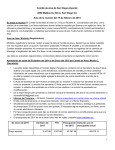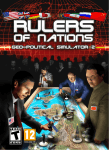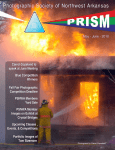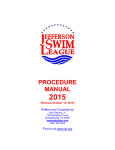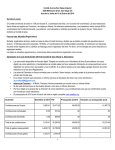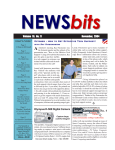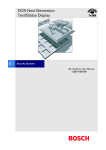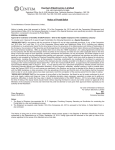Download and print
Transcript
FT
District 11
Guidelines
I am responsible…
A
When anyone, anywhere, reaches out for help,
D
R
I want the hand of A.A. always to be there.
And for that: I am responsible.
CONTENTS
Purposes, Meetings, and Current Practices ……………………………………………….. Page 2
Position Descriptions
FT
DCM, Alternate DCM and Treasurer …………..……………………………………………… Page 3
Alternate Treasurer, Secretary, Alternate Secretary, …………………………………. Page 4
A
and Intergroup Representative
Corrections Chair, Alternate Corrections Chair, …………………………………………. Page 5
D
R
Cooperation with Treatment Facilities Chair,
and Alternate CTF Chair
Cooperation with Professional Community Chair, ……………………………………… Page 6
Alternate CPC Chair, and Grapevine Representative,
and Archivist
Robert’s Rules of Order…………………………………………………………………….. Pages 7 – 11
1
Purpose of Guidelines
The purpose of this document is to provide minimum guidelines for the administrative and
operating procedures of District 11 of Alcoholics Anonymous. These guidelines include
coordination of activities and are subject to change as necessary.
Purpose of District 11
FT
To facilitate interest in general service by encouraging involvement in service at all levels. To
provide information and support to groups, including new group resources and periodically
scheduling service workshops. Also provide a structured forum for GSR sharing. We strive to be
a link for all groups within the district to each other and Oregon Area 58.
Meetings
D
R
A
At this time District 11 meets the last Thursday of each month, 7:00pm at the URS Club. Unless
meetings fall on a holiday, then a vote will take place to reschedule. Meetings will follow an
agenda set forth by the DCM and voting will follow the modified Roberts Rules of Order.
Current Practices
District fully funds DCM to each Area Quarterly Assembly and fully funds Alt. DCM to one of the
Quarterly Assemblies each year. Three $50 dollar scholarships are made available to help out
GSR’s that may need additional funding to attend Area Quarterly Assemblies. As funds allow
District fully funds the DCM to attend PRASSA and or Conferences.
2
DCM
Duties – are as outlined to what is outlined in the DCM pamphlet and the AA General Service
Manual as well as…
Term – 2 years
A
Alternate DCM
FT
Prepares Agenda and Chairs District Business Meetings
Attends Area Assemblies along with PRASSA, PNC, and Regional Forums if district funds
are available.
Help keep the District Meeting Schedule up to date.
Make sure the Oregon Area Roster is correct and if not help GSR’s to update their
information.
Share duties and information with the Alternate DCM.
Communicate and share duties and information with the Alternate.
Duties – To help carry out the duties of the DCM
D
R
Communicates and helps DCM carry out District Business
Fills in when DCM is unavailable.
Term – 2 years
Treasurer
Duties – Keeps finances of District 11 in order
Pick up contributions and to generate a monthly report of funds as well as give this
report orally at the monthly business meetings.
Provide GSR’s with a hard copy so they may take it to their home groups.
Pay any bills the district occurs and write checks as needed.
Communicate and share duties with the Alt. Treasurer.
Term – 2 years
3
Alternate Treasurer
Duties –
Fill in for Treasurer when they are unavailable and help Treasurer keep groups informed
of where district is financially.
Term – 2 years
Secretary
Duties – Keeps District notes and helps members stay current.
FT
Take monthly business minutes and send them out to all GSR’s and Members of District
in a timely manner.
Keep Contact list updated and current.
Help DCM keep District Schedule up to date.
Duties –
D
R
Alternate Secretary
A
Term – 2 years
Fill in for Secretary when needed and help set up monthly business meeting.
Term- 2 years
Intergroup Representative
Duties – To represent District 11
Attend monthly Intergroup meeting and bring back information to report to District
Term – 2 years
4
Corrections Chair
Duties-To represent and keep District 11 informed.
Attend monthly District Business meetings.
Communicates with the Area corrections chair and reports back to district.
Communicates and shares duties with the Alt.
Term – 2 years
Alternate Corrections Chair
FT
Duties Assists the Corrections Chair with duties and fills in when Chair is unavailable.
A
Term – 2 years
Cooperation with Treatment Facilities Chair
D
R
Duties – To represent and keep District 11 informed.
Attends monthly District Business meetings.
Gives Report and shares how members can help support.
Communicates and shares duties with the Alt.
Term – 2 years
Alternate CTF
Duties Assists CTF Chair in duties and fills in when they are unavailable.
Term – 2 years
5
Cooperation with Professional Community Chair
Duties – To represent and keep District 11 informed.
Attends Monthly District meeting.
Communicates with Area Chair.
Gives Reports to District on how we can be of better service.
Communicates and shares duties with Alt.
Term – 2 years
FT
Alternate CPC Chair
Duties –
Assists CPC Chair and fills in when they are unavailable.
A
Term – 2 years
D
R
Grapevine Representative
Duties – To represent and keep District 11 informed.
Attends monthly District Business meeting.
Communicates with Area GVR and gives report at monthly meetings.
Encourages home group members to elect GVR’s
Encourages participation in making the Grapevine available to other service
committees, such as Corrections, CTF and CPC.
Term – 2 years
Archivist
Duties- The following duties are carried out under the direction of the district body.
Collect minutes and any documented information to pass onto Oregon Area.
Term – 4 years
6
Robert’s Rules of Order
Moving to Motion:
A motion is a proposal that the entire membership take action or a stand on an issue. Only
members that can vote on motions may make motions. Motions cannot be made when any
other motion is on the floor. Original motions yield to subsidiary motions such as amendments.
1) Obtain the floor by raising your hand.
2) Make Your Motion.
FT
a) Wait until the last speaker has finished. Always wait until the Chairperson recognizes
you.
A
a) Speak in a clear and concise manner. It is sometimes helpful to write out your motion
before saying it.
b) Always state a motion affirmatively. Say, "I move that we ..." rather than, "I move
that we do not ...”
D
R
c) Avoid personalities and stay on your subject.
3) Second the Motion.
a) Another member will second your motion or the Chairperson will call for a second.
b) If there is no second to your motion it is lost.
c) It is generally not advisable to second a motion to simply get on with the discussion.
The better course is to wait for the motion to fail without a second and then make a
new motion. This avoids the problem of having to overly amend a motion that is not
effectively worded in the first place.
7
4) The Chairperson States Your Motion.
a) The Chairperson will say, "It has been moved and seconded that we ..." Thus placing
your motion before the membership for consideration and action.
b) Once your motion is presented to the membership by the Chairperson it becomes
"assembly property,” and must follow the amendment procedure (below) to be
modified.
5) The Motion is Discussed.
FT
a) The time for you to speak in favor of your motion is at this point in time, rather than
at the time you present it. The mover is always allowed to speak first.
b) All comments and debate must be directed to the Chairperson.
c) The membership then either discuss and debate your motion, or may move directly to
a vote.
A
d) Any member may speak on a motion, but should wait until other speakers are
finished before taking the microphone for a second time.
D
R
e) The mover may speak again only after other speakers are finished, unless called upon
by the Chairperson.
6) Putting the Question to the Membership.
a) The Chairperson asks, "Are you ready to vote on the question?" If there is no more
discussion, a vote is taken.
b) Alternately, a members states "I call the vote" at the microphone.
I) Calling the question requires a second and requires a simple majority to pass.
II) This action is not debatable.
III) The person calling the question must be recognized and speak in turn, calling
the question out of turn, interrupting those who have been waiting to speak,
is out of order and does not have to be recognized by the Chair.
IV) The person calling the question may not address the motion prior to calling
the question.
8
7) Voting on a Motion:
At the discretion of the Chair, one of three methods of voting will be used:
1. By Voice -- The Chairperson asks those in favor to say, "Aye,” those opposed to say
"no”, and ask for any abstentions. The only reason to abstain from the vote is if you
could personally gain or profit from the motion. Any member may move for an exact
count.
2. By a Show of Hands -- Each member raises their hand until all hands are counted.
This method is used for counting dissenting votes also.
Minority Opinion
FT
3. By Ballot -- Members write their vote on a slip of paper; this method is used when
secrecy is desired, such as during elections of committee members. (Please see Third
Legacy voting in your service manual for further instructions.)
A
The minority opinion is very important to AA and helps to preserve our Traditions. Following a
vote, the Chairperson will ask to hear from the minority opinion. The Chairperson can choose
how many minority opinions will be heard. The purpose is to persuade even one person from
the majority to change their opinion and move for reconsideration.
D
R
a) If any member who voted on the prevailing side of the question raise their hands the
request to reconsider a vote is considered made and seconded and discussion
resumes on the matter as if the original vote had not taken place.
b) This is not discussion, and no rebuttal by a member of the majority is allowed.
c) If the motion that is being reconsidered is not debatable, then the motion to
reconsider is not debatable.
d) A matter may be reconsidered only once. Motions to reconsider or table cannot be
subject to a motion to reconsider.
e) Motions to reconsider must be made at the same meeting at which the vote being
reconsidered was taken.
9
Amending a Motion:
When a motion requires change before approval, a motion to amend the motion may be made.
a) A "friendly" amendment is suggested to the person making the motion and accepted
by him. The Chairperson will then restate the question with the amendment
included and discussion on the amended motion continues.
b) A "formal" motion to amend is done by inserting, adding, deleting or changing the
motion. For example, if the motion is to allocate $500.00 to some task, and the
discussion indicated the assembly thought that amount was too much, a member
could amend the motion by saying ”I move to change the motion from $500.00 to
$250.00.”
FT
c) Formal motions to amend must be seconded.
d) If seconded, discussion of the motion to amend takes precedence over the main
motion and the discussion then focuses on the amendment.
D
R
Tabling a Motion:
A
e) Once the assembly votes on the amendment, the discussion of the main motion
resumes.
Tabling a motion has the effect of removing the motion from further consideration at that time,
and postpones it to such time in the future when it is taken off the table.
a) A motion to table requires a second.
b) Motions to table are not debatable.
c) Motions to table require a simple majority to pass.
d) If the matter is to be postponed to a specific time, then the appropriate motion is not
to table, but to postpone until {date}.
10
Point of Order
It is the duty of the Chairperson to enforce the guidelines of the Assembly. It is the right of
each member of the Assembly who notices a shift from these guidelines to bring the problem
the Chair's attention by calling "Point of Order".
a) The Chair may stop discussion that does not follow the guidelines of the Assembly
without calling "Point of Order". An explanation of the guideline will be provided
before discussion on the motion continues.
b) Any member may call "Point of Order" from the Assembly floor.
c) The discussion stops and the Chair will address the guideline question before
continuing.
FT
d) The Chair may request the assistance of a member to act as the Parliamentarian of
the group by suggesting an interpretation of these guidelines to the Chair.
D
R
A
e) A decision is made on the rule or guideline by the Chairperson and discussion is
resumed
11












